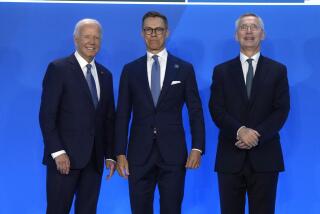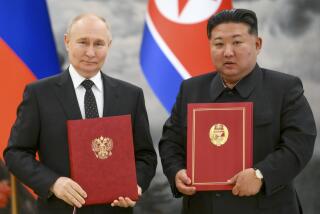U.S.-Soviet Pact Calls for Joint Blast Verification System Tests
- Share via
WASHINGTON — In a step intended to clear the way for Senate ratification of two nuclear test limit treaties in limbo for more than a decade, Secretary of State George P. Shultz and Soviet Foreign Minister Eduard A. Shevardnadze signed an agreement Wednesday calling for joint U.S.-Soviet verification experiments at nuclear test ranges in Nevada and Central Asia.
The agreement, signed in the State Department’s Treaty Room, was one of three pacts issued on the second day of the superpower summit meeting. The others called for increased cooperation in oceanographic research and for direct Moscow-New York airline service by Pan American World Airways and the Soviet carrier, Aeroflot.
According to a joint statement, the United States and the Soviet Union have approved experiments involving a nuclear test verification system that had been suggested by Washington and previously resisted by Moscow.
Uses Cable in Shaft
The system, called Corrtex, requires a cable to be inserted into a shaft drilled a few yards away from the hole used for underground nuclear explosions. The Soviets had objected earlier that the method, by allowing such close access to the site, might permit the United States to spy on Soviet nuclear secrets.
The Soviets have now dropped their political objections, so the only remaining question is whether Corrtex accurately measures underground tests. The purpose of the joint experiments is to determine whether the yields of nuclear test explosions can be measured accurately enough to assure verification of the Threshold Test Ban Treaty of 1974 and the Peaceful Nuclear Explosions Treaty of 1976.
Both pacts prohibit nuclear blasts with yields of more than 150 kilotons, the equivalent of 150,000 tons of TNT. But the treaties were never sent to the Senate for ratification because the administrations of Presidents Gerald R. Ford, Jimmy Carter and Reagan have all maintained that, with existing remote-based technology, the United States could not be certain whether a Soviet test was under or over the limit.
The new agreement calls for an American delegation to visit the Soviet test site at Semipalatinsk in Central Asia and for a Soviet delegation to visit the U.S. site at Mercury, Nev., next month to plan for the experiments. No date was set for the experiments themselves.
According to the joint statement, each side will be given the opportunity to measure one or two explosions at the other side’s test facility. The test explosions will have yields of between 100 and 150 kilotons.
Shultz and Shevardnadze agreed in principle last September on a verification experiment plan but were unable to agree at that time on the method. Washington insisted on the Corrtex method, contending it is more accurate, while Moscow wanted to use seismic measurements. In effect, the agreement signed Wednesday authorizes the use of either method.
If the experiments produce accurate measurements, the joint statement said, the methods will be incorporated into verification systems for the 1974 and 1976 treaties. The threshold treaty limits the yield of underground nuclear tests. The other pact limits blasts declared to be for peaceful purposes, such as altering the course of a river.
Assuming the Senate ratifies the pacts, U.S. and Soviet teams would monitor all future nuclear tests. It would be up to the monitoring team to decide whether to use the Corrtex or the seismic system.
Moscow Prefers Moratorium
Although the Soviets have called for the United States to ratify the 1974 and 1976 treaties, Moscow has said that it would prefer a total moratorium on testing.
The Soviets halted their nuclear test program unilaterally from Aug. 6, 1985, until Feb. 26, 1987, and repeatedly urged the United States to join the moratorium. The Reagan Administration declined. Since the Soviet moratorium ended, the Soviets have conducted 19 tests. The United States has conducted 14 nuclear tests in 1987.
The air agreement establishes the first regular nonstop, round-trip service between Moscow and New York. Beginning May 15, Pan Am and Aeroflot will jointly provide up to three round-trip flights per week, with Pan Am furnishing the cockpit crew and the Boeing 747 and Aeroflot up to three flight attendants. Both airlines serve the two countries at present, but their flights make intermediate stops.
The ocean agreement extends a cooperative arrangement on environmental research in the world’s oceans.
Times staff writer Melissa Healy contributed to this story.
More to Read
Sign up for Essential California
The most important California stories and recommendations in your inbox every morning.
You may occasionally receive promotional content from the Los Angeles Times.










